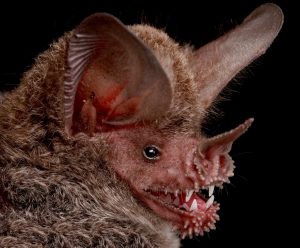Sonar – Part 2
 Last month, we began a new series on echolocation in animals. Active sonar involves an animal emitting a sound wave that bounces off a distant object, returning an echo that provides information about the object’s proximity and size. Over a thousand animal species use sonar. They mostly rely on echolocation to find food in an environment with almost no light. Bats are the ultimate “poster child” of this. We will explore bat sonar in the next two posts. Bat researcher Donald Griffin coined the term “echolocation” in 1954. At first he was mocked for his idea that bats “see” with their ears. Contrary to the familiar phrase “blind as a bat,” bats can actually see better at night than people, But they don’t need to use vision to find food because their sonar is so effective. Some bats can zero in on objects the width of a human hair and accurately strike it in the complete dark. Their big ears and gargoyle skull shapes are designed to enhance echolocation. Wrinkles and grooves around the nostrils of many bats apparently focus incoming sound as well. Bat calls are typically at higher frequencies than what humans hear. As bats get closer to prey, their calls can increase to more than 160 per second. This hyped up sonar mode is called the “buzz phase.” Because sounds dissipate quickly in air, bats can only locate a moth at about a dozen yards from them. Sound intensity helps. A brown bat can screech at 138 decibels, the volume of a jet engine! We cannot hear it because it is ultrasound. But how do they not deafen themselves? They contract a muscles of their inner ears at the instant they screech… a biological hearing protection. Did all this amazing and intricate machinery for sonar evolve to work together by chance mutations? No, clearly these night flyers were designed by an amazing Creator!
Last month, we began a new series on echolocation in animals. Active sonar involves an animal emitting a sound wave that bounces off a distant object, returning an echo that provides information about the object’s proximity and size. Over a thousand animal species use sonar. They mostly rely on echolocation to find food in an environment with almost no light. Bats are the ultimate “poster child” of this. We will explore bat sonar in the next two posts. Bat researcher Donald Griffin coined the term “echolocation” in 1954. At first he was mocked for his idea that bats “see” with their ears. Contrary to the familiar phrase “blind as a bat,” bats can actually see better at night than people, But they don’t need to use vision to find food because their sonar is so effective. Some bats can zero in on objects the width of a human hair and accurately strike it in the complete dark. Their big ears and gargoyle skull shapes are designed to enhance echolocation. Wrinkles and grooves around the nostrils of many bats apparently focus incoming sound as well. Bat calls are typically at higher frequencies than what humans hear. As bats get closer to prey, their calls can increase to more than 160 per second. This hyped up sonar mode is called the “buzz phase.” Because sounds dissipate quickly in air, bats can only locate a moth at about a dozen yards from them. Sound intensity helps. A brown bat can screech at 138 decibels, the volume of a jet engine! We cannot hear it because it is ultrasound. But how do they not deafen themselves? They contract a muscles of their inner ears at the instant they screech… a biological hearing protection. Did all this amazing and intricate machinery for sonar evolve to work together by chance mutations? No, clearly these night flyers were designed by an amazing Creator!Posted on December 1, 2022 by dwoetzel.
